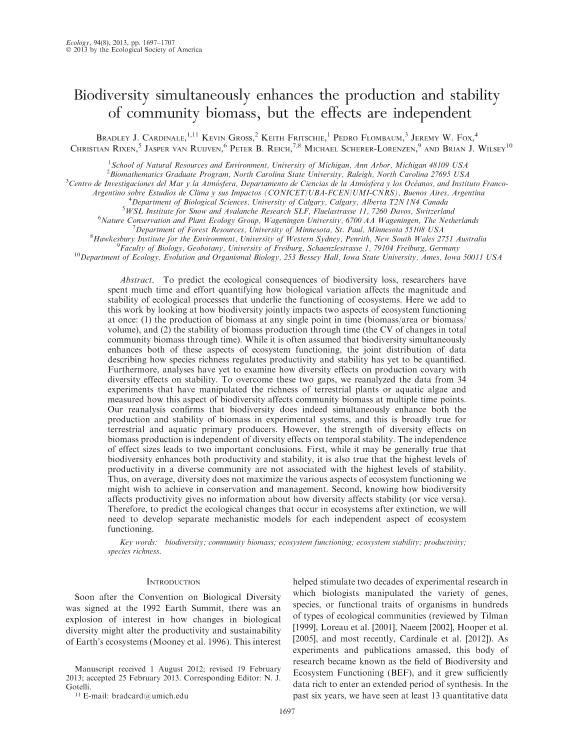Mostrar el registro sencillo del ítem
dc.contributor.author
Cardinale, Bradley J.
dc.contributor.author
Gross, Kevin
dc.contributor.author
Fritschie, Keith
dc.contributor.author
Flombaum, Pedro

dc.contributor.author
Fox, Jeremy W.
dc.contributor.author
Rixen, Christian
dc.contributor.author
Van Ruijven, Jasper
dc.contributor.author
Reich, Peter B.
dc.contributor.author
Scherer Lorenzen, Michael
dc.contributor.author
Wilsey, Brian J.
dc.date.available
2016-03-01T18:49:25Z
dc.date.issued
2013-02
dc.identifier.citation
Cardinale, Bradley J.; Gross, Kevin; Fritschie, Keith; Flombaum, Pedro; Fox, Jeremy W.; et al.; Biodiversity simultaneously enhances the production and stability of community biomass, but the effects are independent; Ecological Society of America; Ecology; 94; 8; 2-2013; 1697-1707
dc.identifier.issn
0012-9658
dc.identifier.uri
http://hdl.handle.net/11336/4560
dc.description.abstract
Human domination of the planet is dismantling Earth´s ecosystems one gene, species, and biological trait at a time. To predict the ecological consequences of biodiversity loss, researchers have spent much of the past two decades quantifying how biological variation affects the magnitude and stability of ecological processes that underlie the functioning of ecosystems. Here we add to this work by looking at how biodiversity jointly impacts two aspects of ecosystem functioning at once: (1) the production of biomass at any single point in time (biomass area-1 or volume-1), and (2) the stability of biomass production through time (the CV-1 of changes in total community biomass through time). While is often assumed that biodiversity simultaneously enhances both aspects of ecosystem functioning, the joint distribution of data describing how species richness impacts productivity and stability has yet to be quantified. Furthermore, analyses have yet to examine how diversity effects on production covary with diversity effects on stability. To overcome these two gaps, we re-analyzed 34 experiments that have manipulated the richness of terrestrial plants or aquatic algae and measured how diversity affects community biomass at multiple time points. Our re-analysis confirms that biodiversity does indeed simultaneously enhance both the production and stability of biomass, and this is broadly true for a variety of primary producers. However, the strength of diversity effects on biomass production is independent of diversity effects on temporal stability. Independence of effect sizes leads to two important conclusions. First, while it may be generally true that biodiversity enhances both productivity and stability, it is also true that the highest levels of productivity in a diverse community are not associated with the highest levels of stability. Thus, on average, diversity does not maximize the various aspects of ecosystem functioning we might wish to achieve in the conservation and management. Second, knowing how biodiversity affects productivity gives no information about how diversity affects stability (or vice versa). If we are to understand and predict the variety of ecological changes that occur in ecosystems after extinction, it is imperative that we develop separate mechanistic models for each independent aspect of ecosystem functioning.
dc.format
application/pdf
dc.language.iso
eng
dc.publisher
Ecological Society of America

dc.rights
info:eu-repo/semantics/openAccess
dc.rights.uri
https://creativecommons.org/licenses/by-nc-sa/2.5/ar/
dc.subject
Biodiversidad
dc.subject
Productividad
dc.subject
Estabilidad
dc.subject
Funcionamiento de Ecosistemas
dc.subject.classification
Ecología

dc.subject.classification
Ciencias Biológicas

dc.subject.classification
CIENCIAS NATURALES Y EXACTAS

dc.title
Biodiversity simultaneously enhances the production and stability of community biomass, but the effects are independent
dc.type
info:eu-repo/semantics/article
dc.type
info:ar-repo/semantics/artículo
dc.type
info:eu-repo/semantics/publishedVersion
dc.date.updated
2016-03-30 10:35:44.97925-03
dc.journal.volume
94
dc.journal.number
8
dc.journal.pagination
1697-1707
dc.journal.pais
Estados Unidos

dc.journal.ciudad
Washington
dc.description.fil
Fil: Cardinale, Bradley J.. University of Michigan. School of Natural Resources and Environment; Estados Unidos
dc.description.fil
Fil: Gross, Kevin. North Carolina State University. Biomathematics Graduate Program; Estados Unidos
dc.description.fil
Fil: Fritschie, Keith. University of Michigan. School of Natural Resources and Environment; Estados Unidos
dc.description.fil
Fil: Flombaum, Pedro. Consejo Nacional de Investigaciones Científicas y Técnicas. Oficina de Coordinacion Administrativa Ciudad Universitaria. Centro de Investigaciones del Mar y la Atmósfera; Argentina. Instituto Franco-Argentino sobre Estudios de Clima y sus Impactos; Argentina
dc.description.fil
Fil: Fox, Jeremy W.. University of Calgary. Department of Biological Sciences; Canadá
dc.description.fil
Fil: Rixen, Christian. WSL Institute for Snow and Avalanche Research SLF; Suiza
dc.description.fil
Fil: Van Ruijven, Jasper. Wageningen University. Nature Conservation and Plant Ecology Group; Países Bajos
dc.description.fil
Fil: Reich, Peter B.. University of Minnesota. Department of Forest Resources; Estados Unidos. University of Western Sydney. Hawkesbury Institute for the Environment; Australia
dc.description.fil
Fil: Scherer Lorenzen, Michael. University of Freiburg. Faculty of Biology, Geobotany; Alemania
dc.description.fil
Fil: Wilsey, Brian J.. Iowa State University. Department of Ecology, Evolution and Organismal Biology; Estados Unidos
dc.journal.title
Ecology

dc.relation.alternativeid
info:eu-repo/semantics/altIdentifier/url/http://onlinelibrary.wiley.com/wol1/doi/10.1890/12-1334.1/abstract
dc.relation.alternativeid
info:eu-repo/semantics/altIdentifier/doi/http://dx.doi.org/10.1890/12-1334.1
dc.relation.alternativeid
info:eu-repo/semantics/altIdentifier/issn/0012-9658
Archivos asociados
